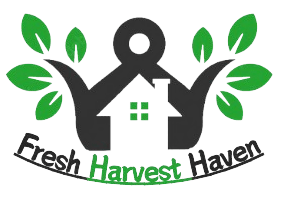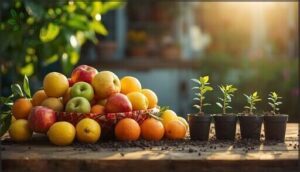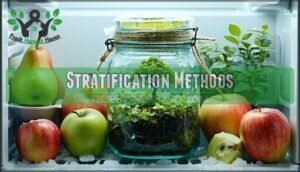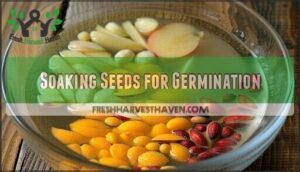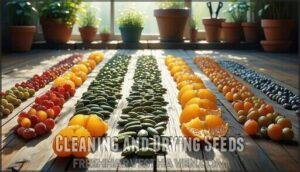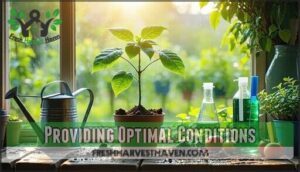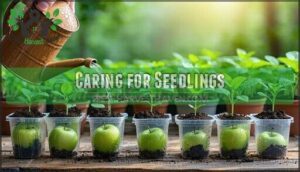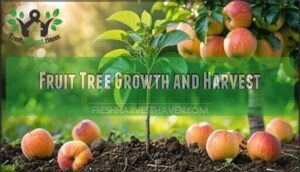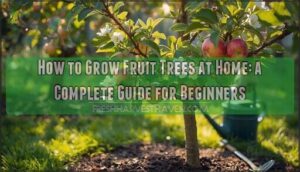This site is supported by our readers. We may earn a commission, at no cost to you, if you purchase through links.
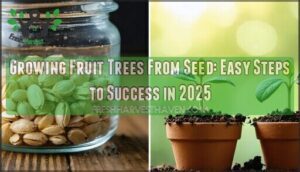
Start with fresh seeds from ripe, healthy fruits you’ve enjoyed eating. Most seeds need cold stratification—think of it as winter boot camp that breaks their dormancy.
Apple and pear seeds require 90 days in your fridge, while citrus seeds can skip this step entirely. Plant in well-draining soil at twice the seed’s depth, keep consistently moist but not waterlogged, and provide bright, indirect light.
Your seedlings will reward your patience with stronger root systems than grafted trees, though the waiting game means 3-7 years before that first sweet harvest. The secret lies in understanding each variety’s unique personality and quirks.
Table Of Contents
- Key Takeaways
- Growing Fruit Trees
- Preparing Seeds for Planting
- Planting Fruit Tree Seeds
- Caring for Seedlings
- Fruit Tree Growth and Harvest
- Frequently Asked Questions (FAQs)
- How long does it take for fruit trees to grow from seed?
- What is the easiest fruit tree to grow from seed?
- Why can’t you grow fruit trees from seeds?
- How long does it take to grow a fruit tree from a seed?
- Can fruit trees be grown indoors successfully?
- Do fruit trees require specific fertilizers or nutrients?
- How do pests and diseases affect seedlings?
- What are the best companion plants for fruit trees?
- Are pollinators necessary for fruit tree growth?
- Can fruit trees cross-pollinate with different varieties?
- Conclusion
Key Takeaways
- Start with fresh seeds and proper preparation – You’ll need viable seeds from ripe fruit, with most requiring cold stratification (90 days in the fridge for apples/pears) to break dormancy before planting.
- Plant in well-draining soil at proper depth – You’ll want to plant seeds at twice their diameter in depth in sandy loam soil with a pH of 6.0-7.0, spacing them 6-12 inches apart.
- Maintain consistent moisture and light – You’ll need to keep the soil consistently moist but not waterlogged, while providing 6+ hours of bright, indirect sunlight daily.
- Exercise patience for harvest rewards – You’ll wait 3-10 years for your first fruit, depending on the variety, but seedlings develop stronger root systems and better disease resistance than grafted trees.
Growing Fruit Trees
You can grow your own fruit trees from seed using grocery store fruits, though they won’t match the parent variety.
Start by selecting healthy, ripe fruits and following specific preparation methods for each type to guarantee successful germination.
Choosing Right Seeds
Why settle for mediocre fruit tree seeds when quality determines your harvest? Your seed selection sets the foundation for years of homegrown fruit.
Quality seeds are the secret ingredient to your backyard orchard success—choose wisely, harvest abundantly.
Choose seeds that’ll give you the best shot at success:
- Seed viability – Fresh seeds from ripe fruit show higher germination rates than old stock
- Fruit varieties – Match your climate zone to avoid winter-killed trees
- Seed sources – Certified nurseries provide disease-free, genetically reliable options
- Seed quality – Healthy, undamaged seeds produce stronger seedlings
Understanding easy fruit options is essential for a successful harvest.
Smart seed selection means better growing fruit trees from seed outcomes.
Seed Selection Tips
Start with seed quality – you’ll want fresh, unblemished seeds from ripe fruit.
Seed viability drops quickly, so avoid old or damaged specimens.
Consider your fruit variety carefully; some trees adapt better to local conditions than others.
Seed storage matters too – keep them cool and dry until planting.
Check germination rates for your chosen species, as some seeds sprout faster than others.
Seed selection sets the foundation for your future orchard’s success.
Common Fruit Trees to Grow
Among fruit tree varieties, apples and citrus trees offer excellent seed viability for beginners.
These tree varieties have predictable growth rates and reliable harvest timing.
When selecting fruit tree seeds, consider your climate zone and space requirements.
Growing fruit trees from seed requires patience, but fruit tree cultivation through seed germination rewards you with unique varieties you can’t buy elsewhere.
Preparing Seeds for Planting
Before you start planting, you’ll need to prepare your seeds properly to give them the best chance of germinating successfully.
The right preparation method depends on your seed type—some need cold stratification, others just a good soak, and all benefit from proper cleaning.
Stratification Methods
Cold Stratification breaks seed dormancy by mimicking winter’s chill. Mix seeds with moist sand or peat moss, then refrigerate for 30-90 days at 34-41°F.
This Winter Simulation softens coats and triggers Seed Germination. Moist Stratification prevents drying while Seed Chilling accumulates necessary Chill Hours, releasing your seeds’ potential for successful sprouting.
For effective results, using proper seed stratification techniques is vital.
Soaking Seeds for Germination
Once your seeds are properly stratified, seed soaking becomes your next breakthrough step.
Soak most seeds for 12-24 hours in lukewarm water—this simple trick doubles germination rates by softening tough seed coats.
Water temperature matters: lukewarm speeds things up while cold water slows progress.
Don’t overdo it though—excessive soaking kills seed viability through rot.
Smart soak duration and proper germination techniques transform stubborn seeds into enthusiastic sprouts, giving you serious seed starting success.
Cleaning and Drying Seeds
After soaking, proper seed cleaning and drying guarantee healthy germination. Remove all fruit pulp completely—leftover bits invite mold and rot. Rinse seeds under cool water, scrubbing gently with your fingers. Pat dry with paper towels, then air-dry for 24 hours before storage. Test seed viability by dropping them in water; sinkers are usually viable, floaters aren’t worth your time.
Understanding soil preparation techniques is vital for a successful garden.
Steps for Seed Preparation:
- Remove pulp completely
- Rinse seeds with clean water
- Pat dry with towels
- Test viability through float tests
- Store in cool, dry place
- Imagine this: your cleaned seeds lined up like little soldiers, ready for their underground mission to become towering fruit trees.
Planting Fruit Tree Seeds
Now that you’ve prepared your seeds, it’s time to get them in the ground where they can start their journey to becoming fruit-bearing trees.
The key to success lies in choosing the right soil mix, planting at the proper depth, and creating conditions that’ll make your seeds feel right at home.
Selecting Right Soil
The right fruit tree soil sets your seedlings up for success. Soil types matter—choose well-draining sandy loam that won’t waterlog your precious seeds.
Heavy clay’s a no-go; it’ll suffocate roots faster than you can say "root rot."
Test your soil pH first. Most fruit trees prefer slightly acidic to neutral levels (6.0-7.0).
Soil preparation involves mixing compost mixtures into your gardening soil for better nutrient content. Drainage systems are vital—if water pools, your seeds won’t thrive.
Soil selection determines everything downstream. Understanding proper fruit tree care is essential for a healthy harvest.
Planting Depth and Spacing
With your soil ready, proper seed depth and plant spacing determine your seedlings’ success.
Plant seeds at twice their diameter depth—this guarantees the best root growth without drowning delicate embryos.
Space seeds 6-12 inches apart to prevent competition for nutrients and light.
- Measure seed depth carefully—too shallow invites birds, too deep suffocates growth
- Create consistent spacing using a ruler or your thumb as a guide
- Press gently into soil to avoid compaction that stunts development
- Mark planting spots with stakes to track germination progress
- Water lightly after planting to settle seeds without washing them away
Providing Optimal Conditions
Your seedlings need the right environment to thrive. After planting, focus on Soil Quality first – maintain pH between 6.0-7.0 for ideal nutrient uptake.
Water Management is vital; keep soil consistently moist but never waterlogged, as soggy conditions kill more seedlings than drought.
Temperature Control and Humidity Levels work together during seed germination. Most fruit tree seedlings prefer 65-75°F with 60-70% humidity.
Light Exposure matters too – provide 6+ hours of bright, indirect sunlight daily.
Monitor your tree seedlings weekly, adjusting conditions as needed. Remember, growing fruit trees from seed requires patience – cold stratification and proper care lead to healthy fruit tree growth stages.
Caring for Seedlings
Once your fruit tree seeds sprout, they’ll need consistent care to develop into healthy seedlings.
You’ll want to focus on proper watering, ideal growing conditions, and gentle training to help them thrive.
Watering and Humidity
Your green thumbs will master watering and humidity control with these simple techniques. Check soil moisture daily—it should feel like a wrung-out sponge, not soggy. Water frequency depends on your seedlings’ thirst, but light daily watering prevents root rot while maintaining hydration.
Here’s your moisture control game plan:
- Morning watering routine: Water gently at soil level, avoiding leaves to prevent fungal issues
- Humidity dome magic: Cover seedlings with clear plastic to maintain consistent humidity levels around 60-70%
- Air circulation flow: Use a small fan on low setting to prevent mold while keeping moisture balanced
Smart irrigation methods like bottom watering let roots drink naturally. Your seedling care success depends on finding that sweet spot between desert and swamp conditions.
Maintaining Temperature and Light
Master your seedling’s environment by controlling temperature fluctuation and light exposure. Maintain optimal temperatures between 65-75°F using heat mats for consistent soil warming.
Position seedlings near east or west-facing windows, providing 12-16 hours daily light exposure. Use grow lights when natural light isn’t sufficient.
Monitor humidity control and make certain proper air circulation around your plants. These seed germination techniques create the perfect conditions for robust growth, preventing leggy seedlings and temperature stress that can derail your fruit tree dreams.
Understanding indoor grow lights is vital for supplementing natural light and promoting healthy plant development.
Pruning and Training
Young trees respond beautifully to thoughtful shaping once they’re established. Pruning techniques help create strong frameworks, while branch training guides growth patterns for ideal fruit production. A key aspect is to improve airflow and sunlight by pruning correctly.
Essential tree shaping practices include:
- Removing weak, crossing branches that compete for nutrients
- Using stakes or wire guides to direct branch training upward
- Cutting damaged wood to prevent disease spread
- Maintaining balanced canopy through selective pruning
- Performing gentle root pruning if plants become pot-bound
Start fruit tree pruning early in tree growth stages to establish proper structure. Light pruning during dormancy encourages vigorous spring growth. Remember, fruit tree maintenance includes fruit thinning later to prevent branch breakage and improve fruit quality.
Fruit Tree Growth and Harvest
You’ll watch your fruit tree seedlings grow slowly at first, then suddenly take off once their roots establish.
Most fruit trees need 3-10 years to produce their first harvest, but the wait’s worth it when you bite into that first homegrown apple or peach.
Time to Bear Fruit
Your fruiting timeline depends on variety influence and environmental impact.
Fast growers like moringa fruit in one year, while apples need patience—requiring 6-10 years.
Seed propagation naturally takes longer than grafting effects, but growing fruit trees from seed offers unique rewards.
Seedlings develop at their own pace.
Understanding climate suitability is vital for ideal growth.
Factors Affecting Growth
Several factors determine how well your fruit tree seedlings will flourish. Soil composition matters most—well-draining loamy soil with proper pH prevents root suffocation.
Sunlight exposure and water availability fuel growth, while pest control protects vulnerable seedlings. Climate impact can’t be ignored either.
Key factors for successful growing fruit trees:
- Soil quality – pH 6.0-7.0, organic matter, proper drainage
- Environmental conditions – 6+ hours sunlight, consistent moisture, stable temperatures
- Protection – pest management, disease prevention, weather shields
Harvesting and Enjoying Fruit
After years of nurturing your fruit trees from seedlings, it’s time to reap what you’ve sown.
Ideal ripeness varies by fruit type, but you’ll know it’s ready when it gives slightly to gentle pressure and releases its signature aroma. Perfect harvesting techniques make all the difference in flavor and storage life.
Here’s how to maximize your homegrown bounty:
- Harvest at peak ripeness – Early morning picking preserves freshness and extends fruit storage potential
- Explore culinary uses – Transform your harvest into jams, pies, or freeze portions for year-round enjoyment
- Master fruit preservation – Proper storage techniques keep your fruit tree harvesting rewards fresh for months
Frequently Asked Questions (FAQs)
How long does it take for fruit trees to grow from seed?
You’ll wait 1-13 years depending on the variety. Fast growers like moringa and papaya fruit within a year, while citrus and apples take 6-10 years to bear fruit.
What is the easiest fruit tree to grow from seed?
Did you know that 89% of home gardeners fail at growing fruit trees from seed.
You’ll have the best luck with papaya trees.
Simply plant fresh seeds directly from ripe fruit, keep them warm and moist, and you’ll see sprouting within weeks, which is a key factor for growing fruit trees from seed.
Why can’t you grow fruit trees from seeds?
You can grow fruit trees from seeds, but they won’t produce the same fruit as the parent.
Most store-bought fruits are hybrids, so seeds create unpredictable varieties that often taste different or poor.
How long does it take to grow a fruit tree from a seed?
Time varies dramatically by fruit type.
You’ll wait 1-2 years for tropical fruits like papaya and bananas, 3-6 years for citrus and stone fruits, and 5-10 years for apples and pears.
Can fruit trees be grown indoors successfully?
Like a gardener nurturing seedlings in a protective greenhouse, you’ll discover that many fruit trees can thrive indoors with proper care.
Especially citrus varieties and dwarf cultivars that adapt well to container growing conditions.
Do fruit trees require specific fertilizers or nutrients?
You’ll need balanced fertilizer with nitrogen for foliage, phosphorus for roots, and potassium for fruit development. Most fruit trees thrive with 10-10-10 or similar ratios applied seasonally.
How do pests and diseases affect seedlings?
Pests attack young seedlings through soft stems and leaves, while diseases thrive in humid conditions, causing root rot, damping-off, and leaf spots that’ll weaken or kill your vulnerable plants.
What are the best companion plants for fruit trees?
While companion plants might seem like an afterthought, they’re actually game-changers for your fruit trees’ health and productivity.
Plant nitrogen-fixing legumes like clover, comfrey for deep nutrients, and herbs like basil to repel pests naturally.
Are pollinators necessary for fruit tree growth?
Yes, you’ll need pollinators for most fruit trees to produce fruit.
While trees grow fine without them, cross-pollination is essential for fruiting.
Some self-pollinating varieties exist, but even these benefit from pollinators for better yields.
Can fruit trees cross-pollinate with different varieties?
Most fruit trees cross-pollinate with different varieties of the same species. You’ll get better fruit set when different apple varieties pollinate each other, creating genetic diversity that often improves yields.
Conclusion
Ironically, while modern gardeners rush to buy instant-gratification nursery trees, growing fruit trees from seed teaches patience that actually pays off.
You’ll discover that homegrown seedlings develop stronger root systems and better disease resistance than their pampered grafted cousins.
Sure, you’ll wait longer for that first juicy apple, but the satisfaction of nurturing a tree from tiny seed to fruit-bearing giant makes every bite taste like victory.
Growing fruit trees from seed connects you to nature’s original timeline.
